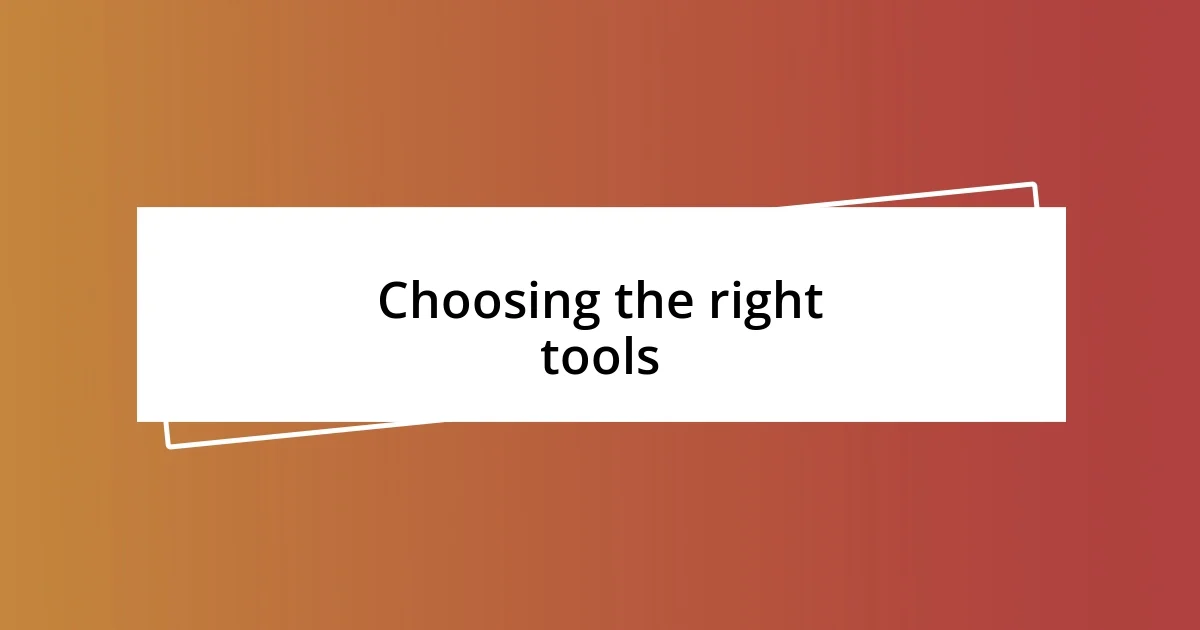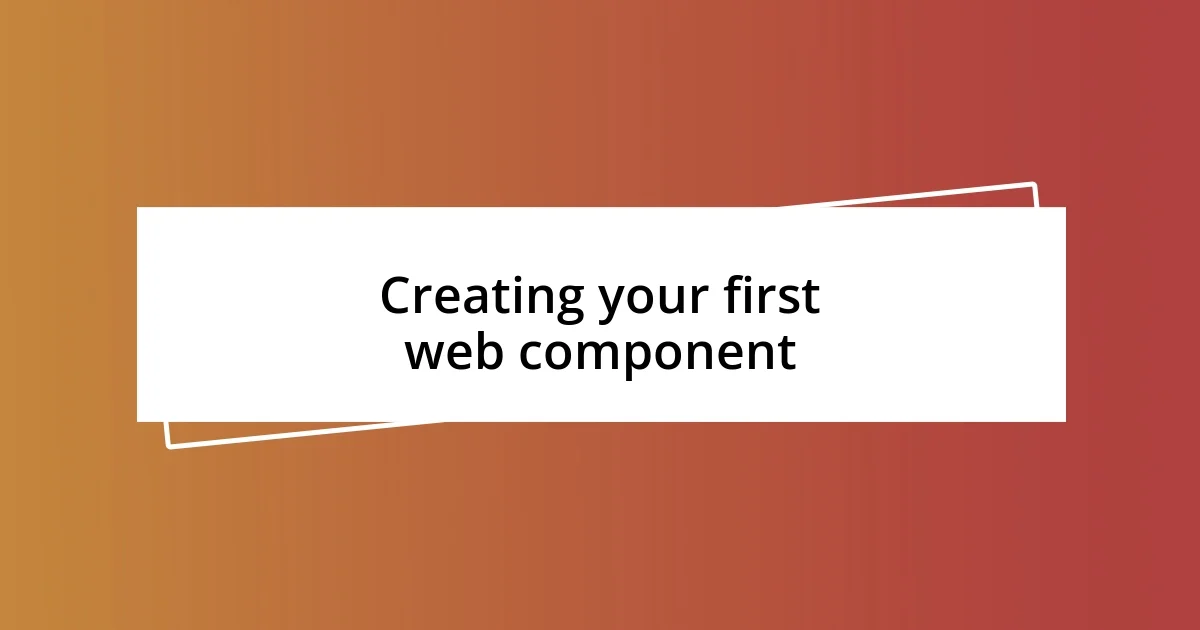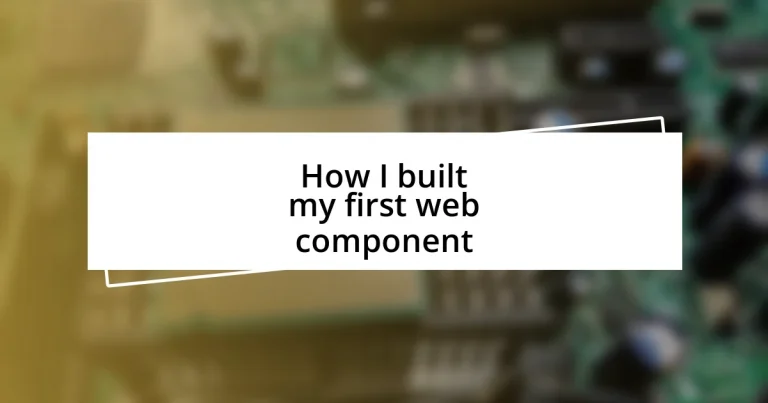Key takeaways:
- Web components allow for reusable, encapsulated elements using shadow DOM, enhancing modularity and independence in web applications.
- Choosing the right tools, such as LitElement and npm, is vital for productivity and simplifying the development process of web components.
- Testing and community engagement are essential steps for ensuring component reliability and sharing knowledge, fostering collaboration and feedback.

Understanding web components
Web components are an exciting way to create reusable custom elements in web applications, and I remember the first time I encountered them during a late-night coding session. The idea that I could encapsulate my HTML, CSS, and JavaScript into a single, self-contained component was a game-changer for me. It made me rethink how I approached building user interfaces—suddenly, everything felt modular and less overwhelming.
One of the most liberating aspects of web components is the shadow DOM. This is like a protective barrier that keeps your element’s styles and scripts from interfering with the rest of the page. I still recall the thrill when I realized that my component wouldn’t get affected by any global styles; it felt like I had superpowers! Isn’t it satisfying to know that you can create something that’s independent and reusable across different projects?
As I immersed myself in the world of web components, I started to appreciate the power of custom elements. It’s fascinating how these elements can have their own properties and methods, much like classes in programming. Have you ever wished for a way to streamline your development process? That’s exactly what custom elements offer—it’s as if you’re building a toolbox that you can use repeatedly, saving time and effort on future projects.

Choosing the right tools
Choosing the right tools can make or break your web component adventure. I remember when I was first diving into this area; the sheer number of frameworks and libraries was overwhelming. Initially, I found myself trying several options, only to realize that simplicity often trumps complexity. In my experience, the best tools are those that enhance the development process rather than complicate it.
Here are some essential tools I recommend considering for your first web component project:
- LitElement: This library simplifies creating web components by handling templating and reactivity, making it a great starting point for beginners.
- Webpack: A powerful module bundler that helps you manage dependencies and optimize your code for production.
- VSCode: My go-to code editor, it’s user-friendly and packed with extensions that can enhance productivity.
- Storybook: This tool provides an interactive way to develop and showcase your components in isolation, which was a game-changer for me.
- Polymer: Although more comprehensive, it provides useful tools for building complex web components if you need them down the line.
Choosing wisely among these tools can greatly enhance your comfort and productivity and ultimately lead to a successful first project.

Setting up your development environment
Setting up your development environment is the first step in bringing your web components to life. I still vividly remember the minor chaos in my workspace when I was getting started. I had to balance the right IDE setup with the necessary dependencies, and it was exhilarating to see everything come together. Trust me, investing time in a solid foundation pays off.
When I configured my first web component environment, I realized that using version control, like Git, was essential. I found myself in a situation where a simple mistake could lead to losing hours of work. So, I embraced Git early on, and it was like having a safety net. Having a reliable system in place affords you the freedom to experiment without fear—an invaluable feeling when trying something new!
You might wonder about the importance of package managers in this process. I remember the time I stumbled upon npm. It felt like unlocking a treasure trove of libraries and modules! Using npm made it easy to manage and install dependencies, streamlining my workflow significantly. The right tools can empower you, and setting up a smooth development environment truly set the stage for the creative exploration of web components.
| Aspect | Description |
|---|---|
| IDE | Choose a user-friendly one like VSCode to enhance productivity and support various extensions. |
| Version Control | Implement Git to save and manage your code effectively. |
| Package Manager | Use npm to easily install and manage dependencies, making development hassle-free. |

Creating your first web component
Creating your first web component is an exciting journey, and I remember the thrill of crafting that initial piece of code. I started with a simple button component, and it was fascinating to see how encapsulating functionality could create something both reusable and elegant. It felt like magic watching the component come to life right before my eyes!
As I delved deeper, I learned that defining a custom element is the cornerstone of building a web component. Using the class keyword followed by extending HTMLElement was a revelation for me. I vividly recall the first time I added a little styling and interactivity to my component—it was rewarding to see a plain block transform into a vibrant part of my project. Have you ever experienced that moment when you realize your code is not just lines on a screen but something functional? That feeling is what keeps you hooked on development.
Don’t forget about testing your components! I used to overlook this step, only to spend hours debugging later. Now, I realize that incorporating tests from the start not only saves time but also helps ensure your component behaves as expected. It’s thrilling to see your creation pass tests, providing a sense of accomplishment that motivates you to build even more. So, as you craft your first web component, remember to celebrate those small victories along the way!

Styling and enhancing your component
When it came to styling my web component, I initially felt overwhelmed by the many options available. I remember the first time I used Shadow DOM to encapsulate my styles—I was thrilled that my component could have its own, unique look without affecting the rest of the application. It was like giving my component its own cozy space. Don’t you love the idea of keeping things neat and tidy?
As I explored the world of CSS, I found that utilizing custom properties, or CSS variables, was a game changer. They allowed me to maintain consistent styling and make global changes easily. I vividly recall updating my button’s color theme with just a few tweaks in my CSS file; it was a delightful feeling to see that change ripple through my component effortlessly. Have you experienced a similar glow of satisfaction when your design comes together?
To enhance interactivity, I began incorporating animations, which added a dynamic element to my component. I’ll never forget the “wow” moment when I added a simple hover effect—suddenly, my button felt alive, welcoming user interaction. Enhancing components with tastefully executed animations can elevate the user experience significantly. It makes me wonder, how much more captivating can our components become with a dash of creativity and imagination?

Testing your web component
Testing your web component is a crucial step that I learned to appreciate after some trial and error. In the beginning, I would just throw my component into a project, hoping it would work perfectly. It wasn’t until I faced unexpected behavior that I realized how invaluable tests could be. I remember the first time I wrote a unit test for a simple method within my component; it was a lightbulb moment that truly opened my eyes to the power of validation.
As I evolved my testing strategy, I discovered the joy of using tools like Jest and testing libraries tailored for web components. One evening, after writing my first automated test, I felt an overwhelming sense of relief when the test passed. It was an affirmation that my code was sound, and I couldn’t help but think—what if everyone embraced this practice? The peace of mind that comes from knowing your component functions correctly is irreplaceable.
I found that integrating visual regression testing also played a significant role in maintaining my component’s integrity. I still remember the frustration of spotting styling inconsistencies in my design after deployment. By using tools like Storybook with snapshot tests, I was able to catch these issues early on, saving time and headaches down the line. It’s quite empowering to know that you have a safety net, don’t you think? Embracing a rigorous testing approach not only fosters confidence in my work but also encourages a more robust development process.

Publishing and sharing your component
Once my web component was polished and tested, the exciting part came—sharing it with others. I vividly remember my first publish; it felt like sending a child off to school! I chose to use npm for distribution, a perfect platform to reach fellow developers. The way it streamlined the packaging and made my component readily available was enlightening. Have you ever felt that rush of anticipation before sharing your creation with the world?
When it comes to promoting your web component, I found that writing a clear and engaging README was essential. It not only documented how to use my component but also conveyed my passion and the story behind it. I spent a lot of time crafting that document. It was rewarding to think about how my thoughts could inspire others to experiment with my component. Don’t you think sharing the “why” behind our creations makes them more relatable and accessible?
I soon learned that engaging with the community greatly amplified my component’s reach. I posted about it on forums and social media, receiving feedback that I hadn’t anticipated. The emails and messages of excitement and suggestions filled me with a sense of connection that I hadn’t expected. Seeing others use my component and incorporate their ideas into it made it feel truly collaborative, like we were all part of something bigger. Isn’t it fascinating how sharing our work can ignite such a dynamic exchange of ideas?














